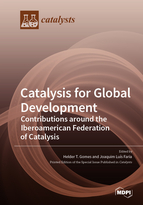Catalysis for Global Development. Contributions around the Iberoamerican Federation of Catalysis
A special issue of Catalysts (ISSN 2073-4344).
Deadline for manuscript submissions: closed (31 January 2019) | Viewed by 65013
Special Issue Editors
Interests: heterogeneous catalysis; magnetic nanocatalysts; carbon-based materials; design, preparation, and characterization of catalysts; advanced oxidation processes; environmental catalysis; catalytic wet peroxide oxidation; valorization of sub-products; chemical engineering
Special Issues, Collections and Topics in MDPI journals
Interests: catalysis and photocatalysis; chemical emergent systems for environment, energy, and fine chemistry; physical-organic chemistry; chemistry and materials science; spectroscopic techniques; advanced oxidation processes; solar fuels; nanotechnology and nanoscience; biophysics and biochemistry; chemical education and science communication; chemical engineering
Special Issues, Collections and Topics in MDPI journals
Special Issue Information
Dear Colleagues,
Following the biennial meetings, held since 1968, the Iberoamerican Federation of Catalysis Societies (FISoCat), the Portuguese Chemical Society (SPQ) and the University of Coimbra jointly organizes the XXVI Iberoamerican Congress on Catalysis (CICat 2018), between the 9th and 14th of September 2018, in Coimbra, Portugal. CICat 2018 is of particular historical importance, as it marks the 50th anniversary of the beginning of this series of meetings. The present Special Issue will feature the works presented at CICat 2018 and also additional contributions, that promote linkage of the catalytic science, technology, education and culture plans and processes, involved in cooperation programs and projects among the Iberoamerican Member States and of these with the states and institutions of other regions.
Authors with expertise in any topic of catalysis are cordially invited to submit their manuscripts to this Special Issue of Catalysts. Significant full papers and review articles are very welcome. The topics of the conference will cover various aspects of catalysis in all of its diversity, as well other areas on the boundaries such as environmental protection, energy, sustainability, nanoscience, fine chemistry, biotechnology, surface chemistry and cultural heritage.
Prof. Dr. Helder GomesProf. Dr. Joaquim Luís Faria
Guest Editors
Manuscript Submission Information
Manuscripts should be submitted online at www.mdpi.com by registering and logging in to this website. Once you are registered, click here to go to the submission form. Manuscripts can be submitted until the deadline. All submissions that pass pre-check are peer-reviewed. Accepted papers will be published continuously in the journal (as soon as accepted) and will be listed together on the special issue website. Research articles, review articles as well as short communications are invited. For planned papers, a title and short abstract (about 100 words) can be sent to the Editorial Office for announcement on this website.
Submitted manuscripts should not have been published previously, nor be under consideration for publication elsewhere (except conference proceedings papers). All manuscripts are thoroughly refereed through a single-blind peer-review process. A guide for authors and other relevant information for submission of manuscripts is available on the Instructions for Authors page. Catalysts is an international peer-reviewed open access monthly journal published by MDPI.
Please visit the Instructions for Authors page before submitting a manuscript. The Article Processing Charge (APC) for publication in this open access journal is 2700 CHF (Swiss Francs). Submitted papers should be well formatted and use good English. Authors may use MDPI's English editing service prior to publication or during author revisions.
Keywords
- Environmental Catalysis
- Industrial Catalysis, Oil Refining, Natural Gas Conversion and Petrochemistry
- Design, Preparation and Characterization of Catalysts
- Sustainable Processes and Clean Energies
- Fine Chemistry
- Biocatalysis
- Homogeneous Catalysis
- Heterogeneous Catalysis
- Photocatalysis







